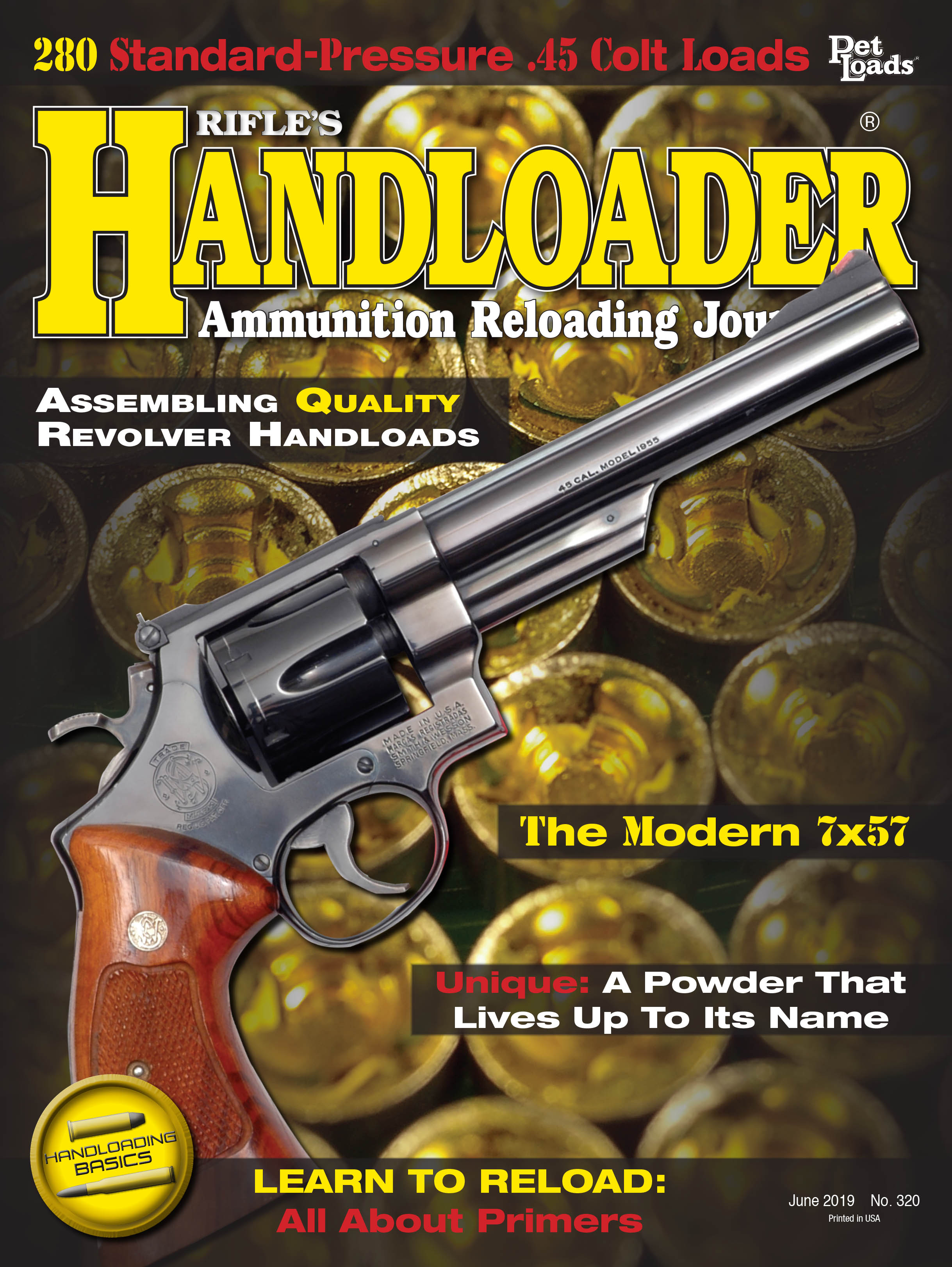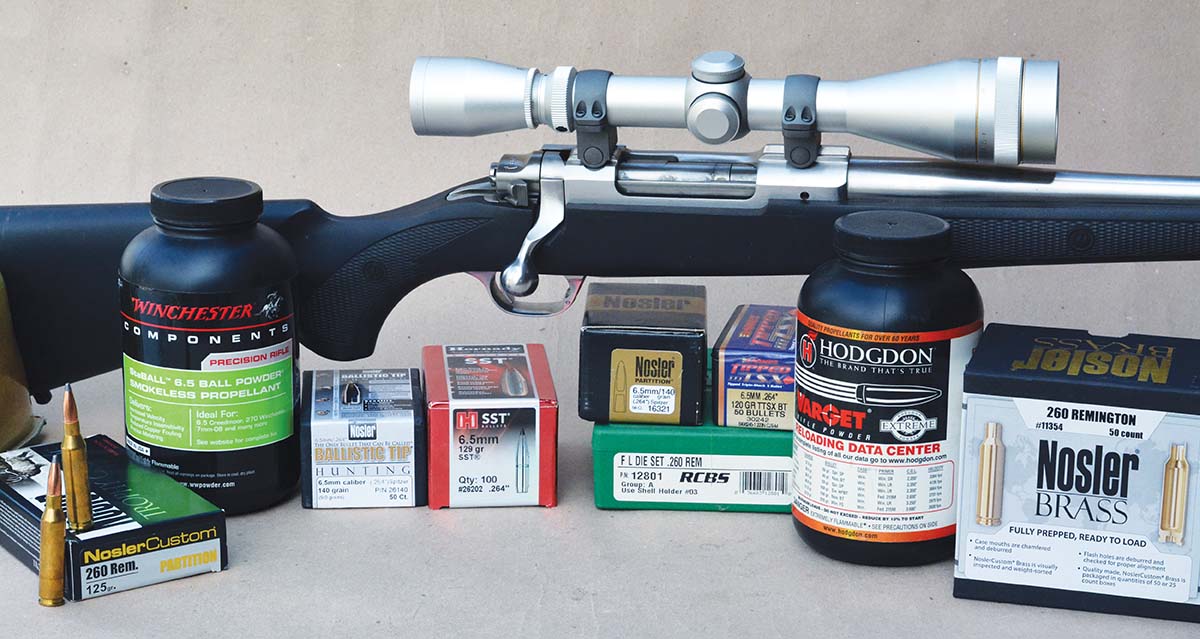
Brian used a Ruger M77 Mark II chambered in 260 Remington to develop “Pet Loads” data.
After nearly 40 years of being a wildcat, the 260 Remington was formally introduced in 1997 and enthusiastically received by savvy riflemen and hunters. It offered many virtues, including modest recoil, flat trajectory, efficiency (in regards to powder charges, high ballistic coefficient [BC] bullets and velocities), and could be housed in 308 Winchester-length, short-action rifles. It proved its value in long-range competitions, and hunters found that it was an excellent open-country deer and antelope cartridge, but with heavier bullets, it is capable of taking larger game, including elk and moose. In addition to Remington, major rifle manufacturers, including Browning, Winchester, Ruger, Savage and many others, began offering rifles.

The 260 Remington is an excellent deer cartridge when hunting in open country.
One of the hardest parts of a “Pet Loads” article is where to begin the history that could be with 6.5 cartridges; however, today we will begin with the 308 Winchester that was introduced by Winchester in 1952 in their wonderful Model 70 rifle. The 308 had a maximum overall cartridge length of 2.810 inches, and most bolt-action rifles were soon designed with a short action specifically for that cartridge (although it took Winchester decades to do so). The military version known as the 7.62 NATO (with only slight changes from the commercialized 308) was developed at the same period and more or less finalized by 1954. It became immediately clear that the 308 Winchester and 7.62 cartridges were modern and would become widely popular with worldwide militaries and civilians alike. By 1955, Winchester necked the 308 down to become the 243 Winchester and also necked it up to become the 358 Winchester.
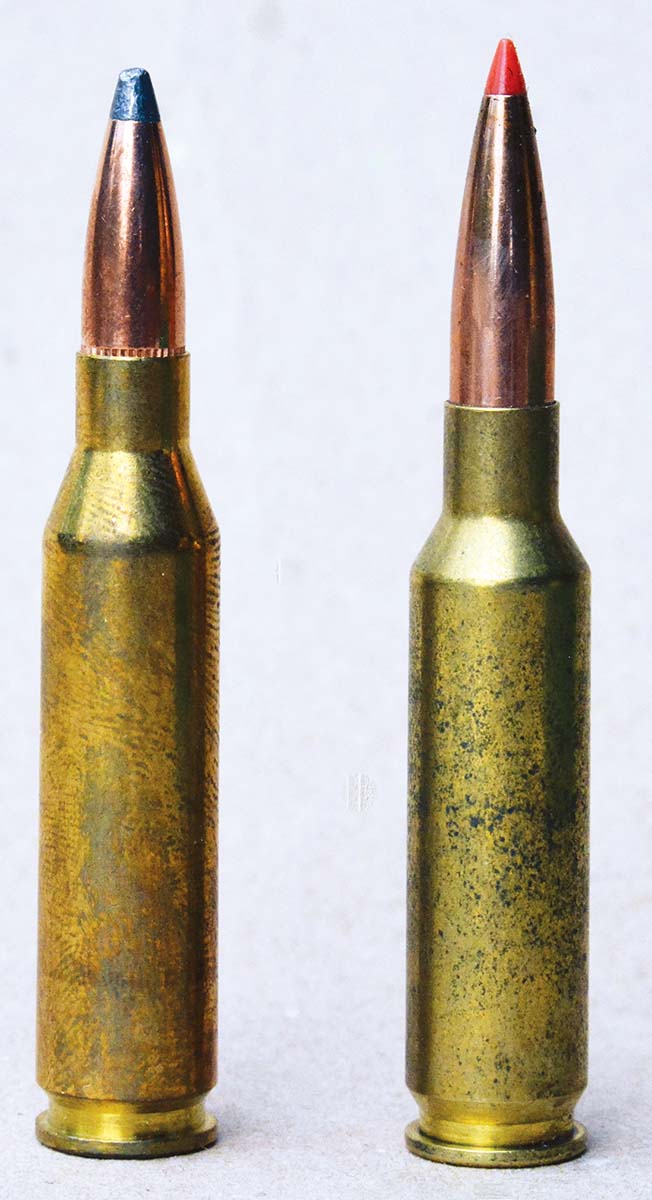
The 260 Remington (left) influenced the development of the 6.5 Creedmoor (right).
But there was a pretty significant (and obvious) caliber void between the 243 and the 308 Winchester. It is unknown who first decided to neck this case to 6.5 caliber, but by 1956 or 1957, the late Ken Waters (former writer for
Wolfe Publishing Company) necked the 243 case up to 6.5 and called it the “263 Express,” and was probably the first to do so. Waters elected to use the 243 Winchester case because it was easier to neck up to .020 inch rather than necking down the 308 Winchester to .045 inch and then reaming the necks. Ken was not overly impressed with the 243’s performance on deer with 1950s vintage cup and core bullets; however, he was familiar with the exploits of the 6.5 Mannlicher and was inspired to create a new cartridge that was based on the modern 308 case and designed to work in short-action rifles. It is noteworthy that the 6.5 Mannlicher (aka 6.5x54mm Mannlicher Schonauer) has an overall cartridge length of 3.063 inches that prevented it from being chambered in rifles with 308 action lengths. Ken was initially using Speer bullets, which at that time measured .263 inch and explains the name of his cartridge. As a bonus, Ken’s 263 Express easily outperformed the 6.5 Mannlicher.
Other experimenters followed, and eventually, the 6.5 wildcat based on the 243/308 case became very popular with hunters and long-range target shooters (including long-range shooting legend David Tubb), but it was known by several names. Noted columnist Jim Carmichel soon recognized the virtues of this wildcat and created what he referred to as the “6.5 Panther” that was more or less identical to Ken Waters’ 263 Express. Carmichel felt the demand was strong and encouraged Remington to introduce it commercially, which became the 260 Remington in 1997. However, it is noteworthy that A-Square submitted drawings to the SAAMI (Sporting Arms and Ammunition Manufacturers’ Institute) of the “6.5-08 A-Square” cartridge months prior to Remington submitting their version. We can only speculate why Remington was awarded their submission.
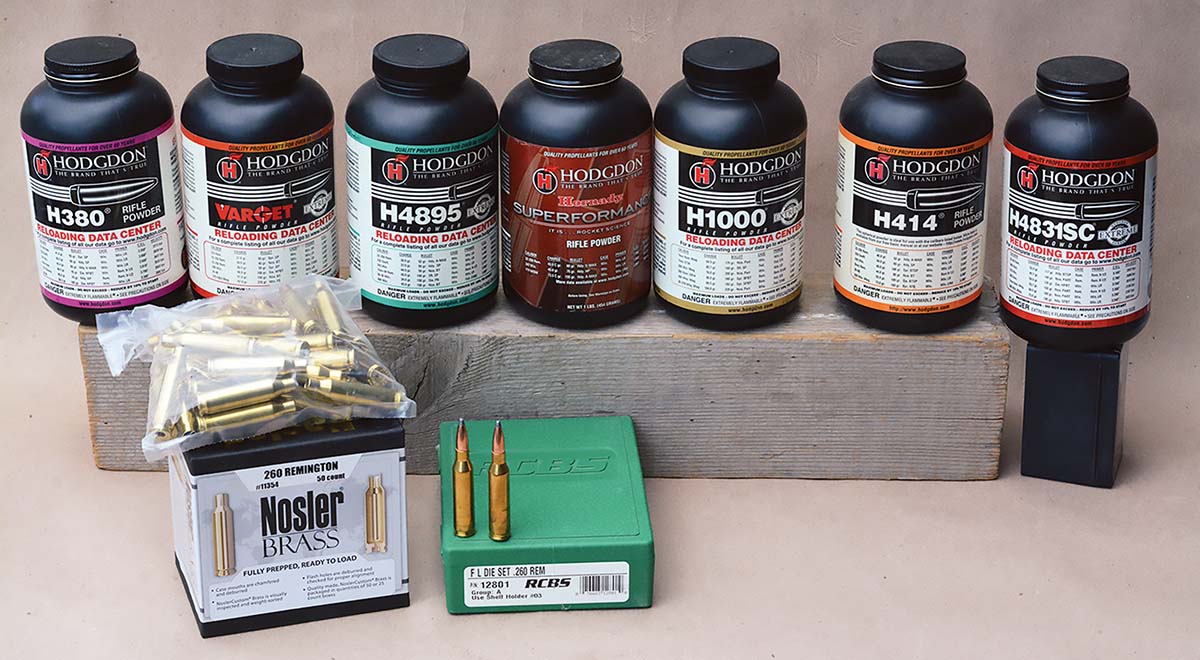
Hodgdon offers many powders with an ideal burn rate for handloading the 260 Remington.
Until the introduction of the 260 Remington, 6.5-caliber rifles had comparatively limited commercial success in the USA. However, they had been very popular for a long time throughout Europe among hunters and long-range competitors. A Remington official told me that developing the 260 Remington was an internal battle due to the 6.5 caliber’s poor general acceptance by U.S. shooters. For example, Winchester announced the impressive 264 Winchester Magnum in 1958/59, but its popularity was very short-lived due to rapid throat erosion, and the 7mm Remington Magnum appeared in 1963, which became far more popular. The 6.5 Remington Magnum (1966) was also a failure, but that was largely due to its introduction in the Model 600 carbine with an excessively short 181⁄2-inch barrel that severely limited performance, not to mention an objectionable muzzle blast. In 1993, the SAAMI standardized the 6.5x55 Swede. While there was interest in the U.S.for that cartridge, Remington certainly did not get rich from the sales of the rifles or ammunition.
As is often the case when a new cartridge is introduced, the 260 Remington enjoyed brisk sales and received positive reviews from many firearm publications. It pushed various .264-inch 140-grain bullets at 2,750 feet per second (fps), or 125-grain bullets at nearly 2,900 fps. However, due to its high BC figures, the retained downrange velocities are high, which is a significant advantage when compared to other cartridges with similar ballistics at the muzzle. This feature alone made it a very interesting cartridge.
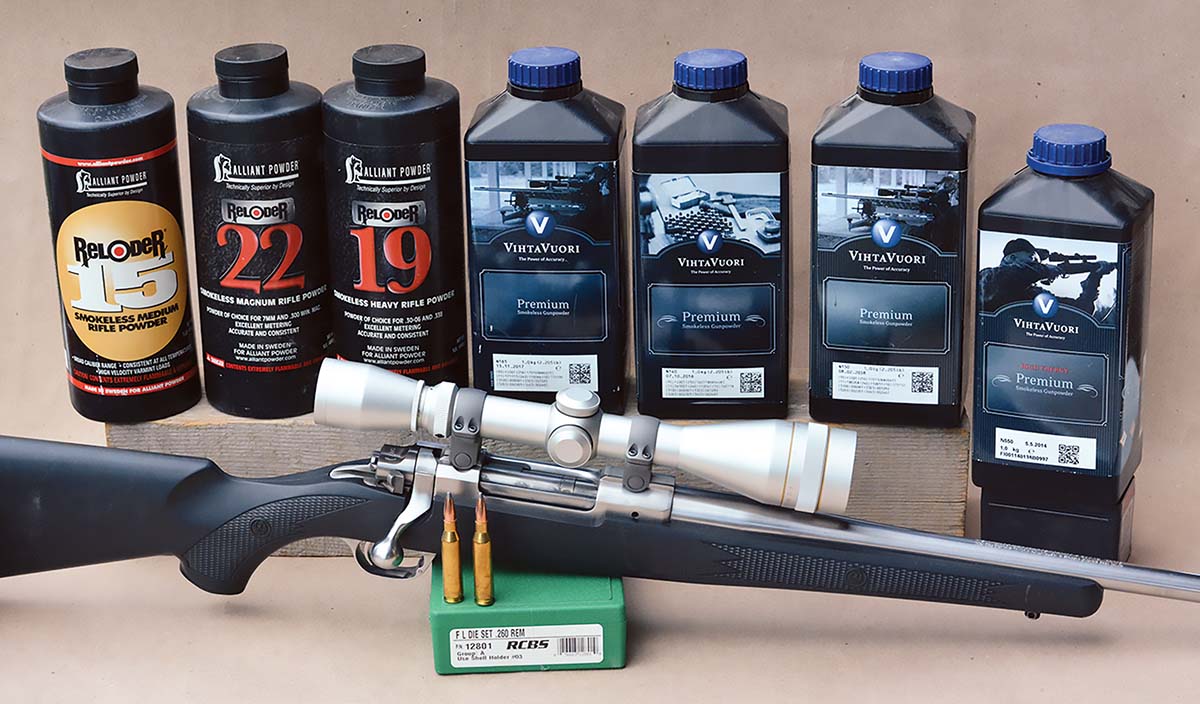
Vihtavuori and Alliant offer many powders that offer both top accuracy and velocities.
The 260 Remington had a very bright future, at least until 2007/08 when another cartridge quietly appeared that offered very similar ballistics, known as the 6.5 Creedmoor, and was designed by Hornady’s Ballistic Scientist Dave Emary and Dennis DeMille (of Creedmoor Sports). Trends and bullet designs were changing, and the 6.5 Creedmoor was designed as an “across the course” high-power target cartridge. While its ballistics (and powder capacity) are actually less than the 260 Remington, it was designed specifically for long-range shooting and corresponding long, heavy-for-caliber high BC, low drag bullets. The 260 Remington shared the same 20-degree shoulder of the 308 Winchester, but the 6.5 Creedmoor had a 30-degree shoulder for improved burn efficiency, reduced throat erosion, and lower extreme spreads. The case body was shortened, allowing long bullets to be seated out and still have an overall cartridge length (2.825 inches) that works in short-action rifles. This feature also gains back some of the reduced powder capacity from the shorter body, but more importantly, bullets can be custom seated to correspond with different throat lengths for top-notch accuracy. The standard barrel twist rate was 1:8 inches, which properly stabilized long, heavy, high BC, low drag bullets at all ranges. It is interesting that the Creedmoor received little press at first, and most shooters were not even familiar with it for several years following its introduction. But when it began to regularly win matches, its popularity soared and soared, and the rest is history, as it is one of the best-selling rifle cartridges in the U.S.
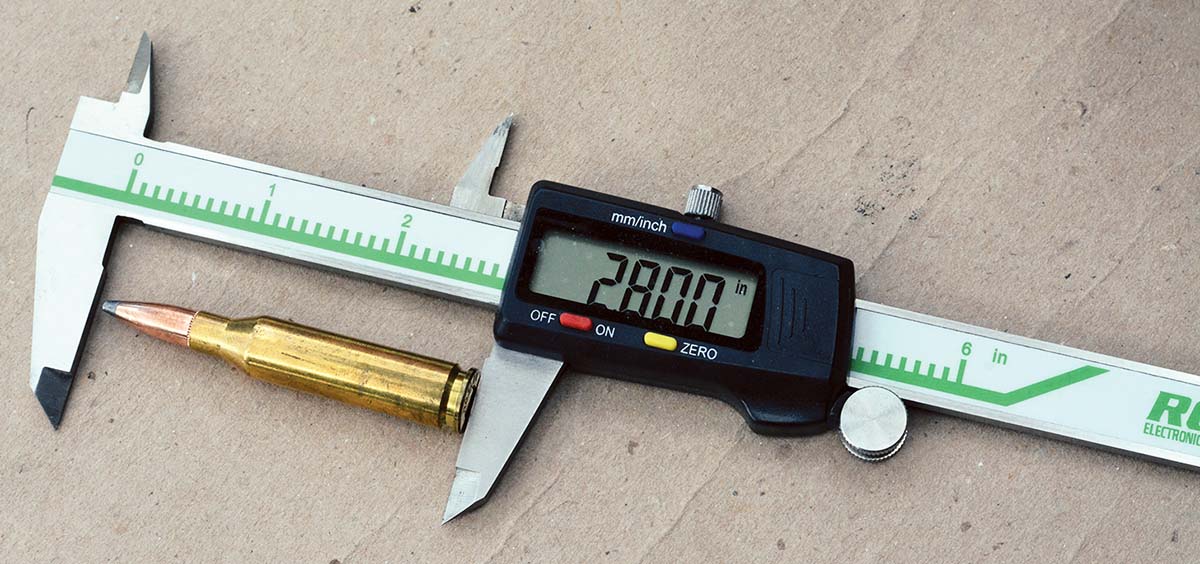
The 260 Remington has a maximum overall cartridge length of 2.800 inches that allows it to function in 308 Winchester length actions.
Back to the 260 Remington; the design is less than perfect when used with some ultra-long-range heavyweight target bullets that feature long boat-tails and stretched ogives. In other words, if the bullets are seated to the cartridge’s maximum overall length of 2.800 inches, part of the ogive is inside the casemouth, which, for multiple reasons, is less than perfect. On the other hand, there are many hunting bullets that weigh between 120 and 140 grains that feature more conventional profiles and can be seated to industry-standard overall lengths that work perfectly. Even though ultra-long-range shooting at inanimate targets is a wonderful skill and fun, generally speaking, at normal distances where big game is taken, there is no practical difference between the 260 Remington and the 6.5 Creedmoor. In other words, at extreme distances where the Creedmoor really begins to show its advantages, neither cartridge has enough power left to decisively take big game. At distances that the vast majority of deer are taken, the 260 Remington offers a slight velocity advantage with typical big game hunting bullets due to its greater powder capacity. It also works perfectly with popular varmint bullets from Nosler, Speer, Hornady, and Sierra that typically weigh between 85 and 100 grains, all of which gave excellent accuracy from the test rifle.
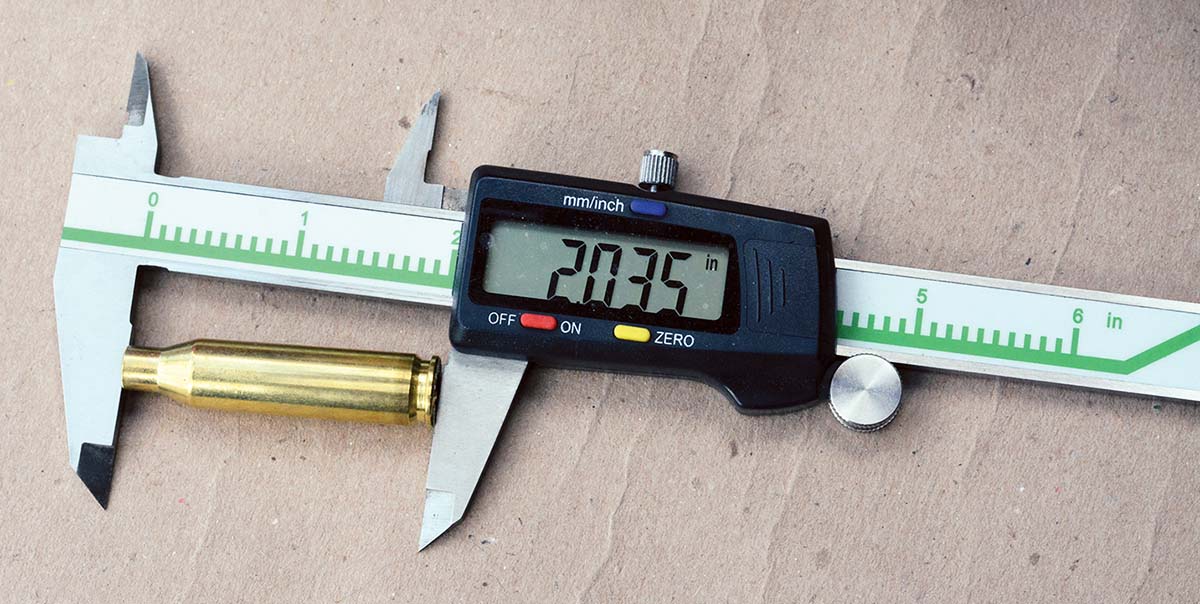
Maximum case length is 2.035 inches.
I cannot help but compare briefly the 260 Remington with the classic 6.5x55mm Swede. I have used the latter in Europe to take boar (not feral hogs), various deer species and even moose. The Swedes have used it for many years on moose with great success, but most hunters rely on heavy bullets that typically weigh around 160 grains with a round nose profile and with a high sectional density for ultra-deep penetration. The 6.5x55mm has an overall cartridge length of 3.150 inches, so it cannot work in 308 Winchester length actions and results in heavier rifles, etc. In addition to the short-action advantage, the 260 Remington works fine with 160-grain roundnose profile bullets, but also easily reaches greater velocities than the 6.5x55mm. With more modern premium bullets that typically weigh 120 to 140 grains, again, the 260 Remington offers a modest velocity advantage and flatter trajectories.
For today’s purposes, a Ruger M77 Mark II All-Weather rifle, topped with a Leupold VX-II 4-12x scope, was selected to develop “Pet Loads” data. In addition to being a highly reliable rifle when testing (as it is very frustrating to have a gun fail during load development), it features a 22-inch barrel with a 1:8-inch twist rate that stabilizes virtually all popular bullet weights. However, it should be noted that twist rates found in 260 Remington rifles vary by manufacturer. For example, Remington also utilizes a 1:8 twist, but Savage uses a 1:9 twist while Browning uses a 1:10 twist. I have reports of Winchester rifles having both 1:9 and 1:10 twists. Some of the slower twist rates will not stabilize some long, heavyweight bullets at long distances, so it will be helpful to identify the twist rate of your rifle prior to purchasing bullets and components and sitting down at the bench.
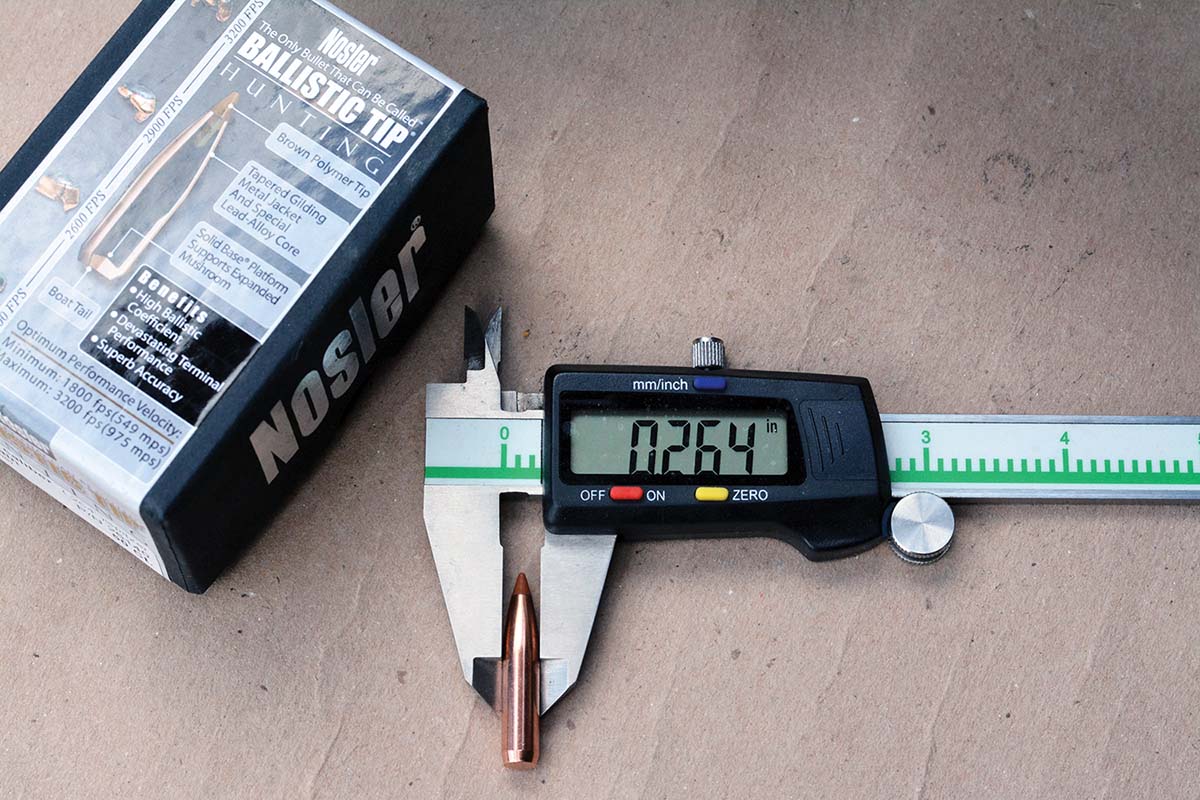
The 260 Remington utilizes 6.5mm or .264-inch bullets.
The SAAMI has a maximum average pressure for the 260 Remington at 60,000 pounds per square inch (psi), which is a story in itself, but it should be at least 62,000 psi or 63,000 psi in this writer’s opinion. Regardless, all loads are within industry pressure guidelines.
NoslerCustom cases were used to develop all loads, which were primed using Federal Gold Medal 210 Match large rifle (standard) primers. I am unaware of who actually manufactured the NoslerCustom cases; however, it should be noted that powder capacity varies by manufacturer.
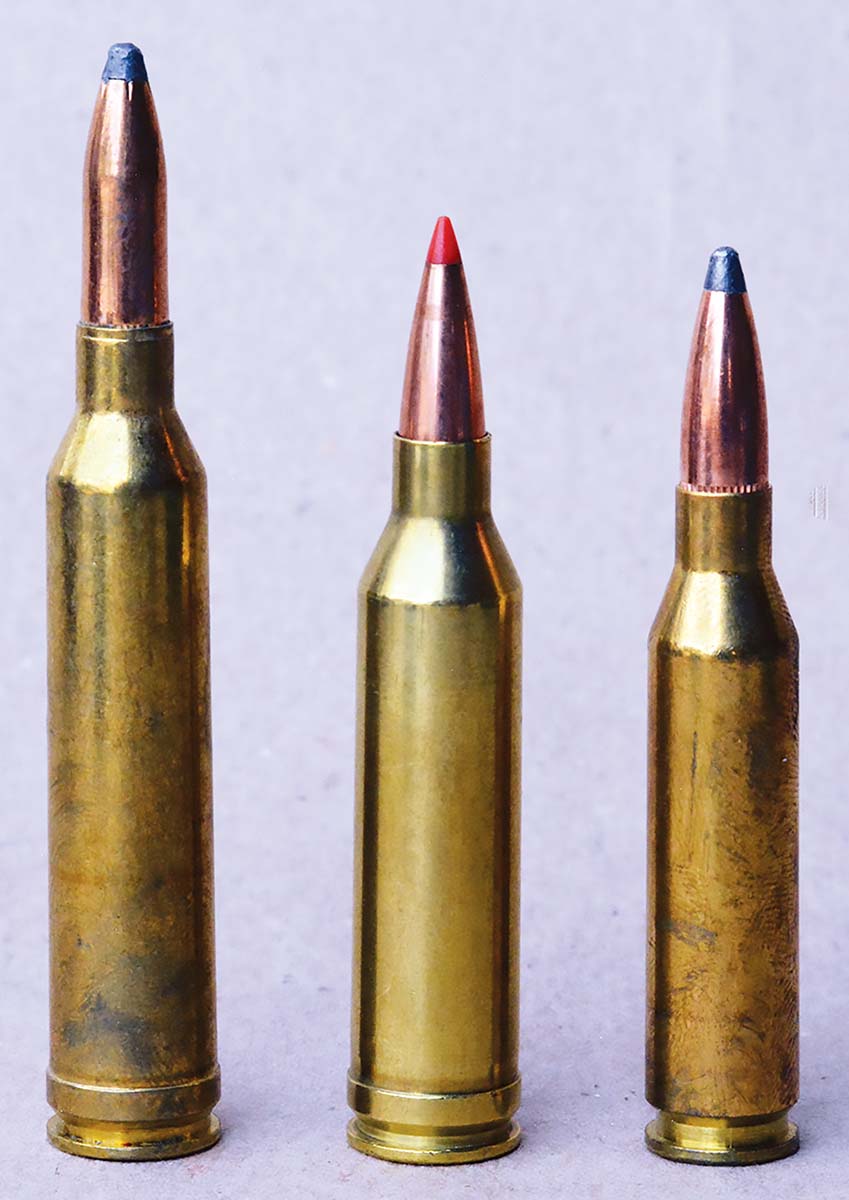
Previous 6.5 caliber U.S. cartridges did not fare well, such as the 264 Winchester Magnum (left) and the 6.5 Remington Magnum (center); however, the 260 Remington (right) had greater appeal.
When seating bullets in the accompanying “Pet Loads” data table, the overall cartridge lengths were held within the SAAMI specifications of 2.800 inches. This allows them to work in all rifles. As experienced handloaders know, seating bullets to correspond with a given rifle’s throat, or seating bullets to find the so-called “sweet spot,” will almost always yield better accuracy. This fine-tune testing must be carried out in the intended rifle. The point being that there is no benefit to readers for me to conduct this type of experimenting in the Ruger rifle, as every rifle is different. Generally speaking, cup and core should be seated close to – but never engaging – the leade. If bullets are seated to engage the leade, pressures will increase. And if handloads are to be used in a hunting rifle, bullets so seated can make it hard to chamber cartridges and can even pull the bullet from the case when removing a cartridge from the chamber, leaving the bullet stuck in the barrel! With that said, I have had some rifles that actually shoot better with bullets seated deep, but those are an anomaly. Regarding the Barnes 120-grain Tipped TSX bullet constructed of copper, generally speaking, the accuracy sweet spot will usually be with the ogive .050 to .100 inch off the leade.
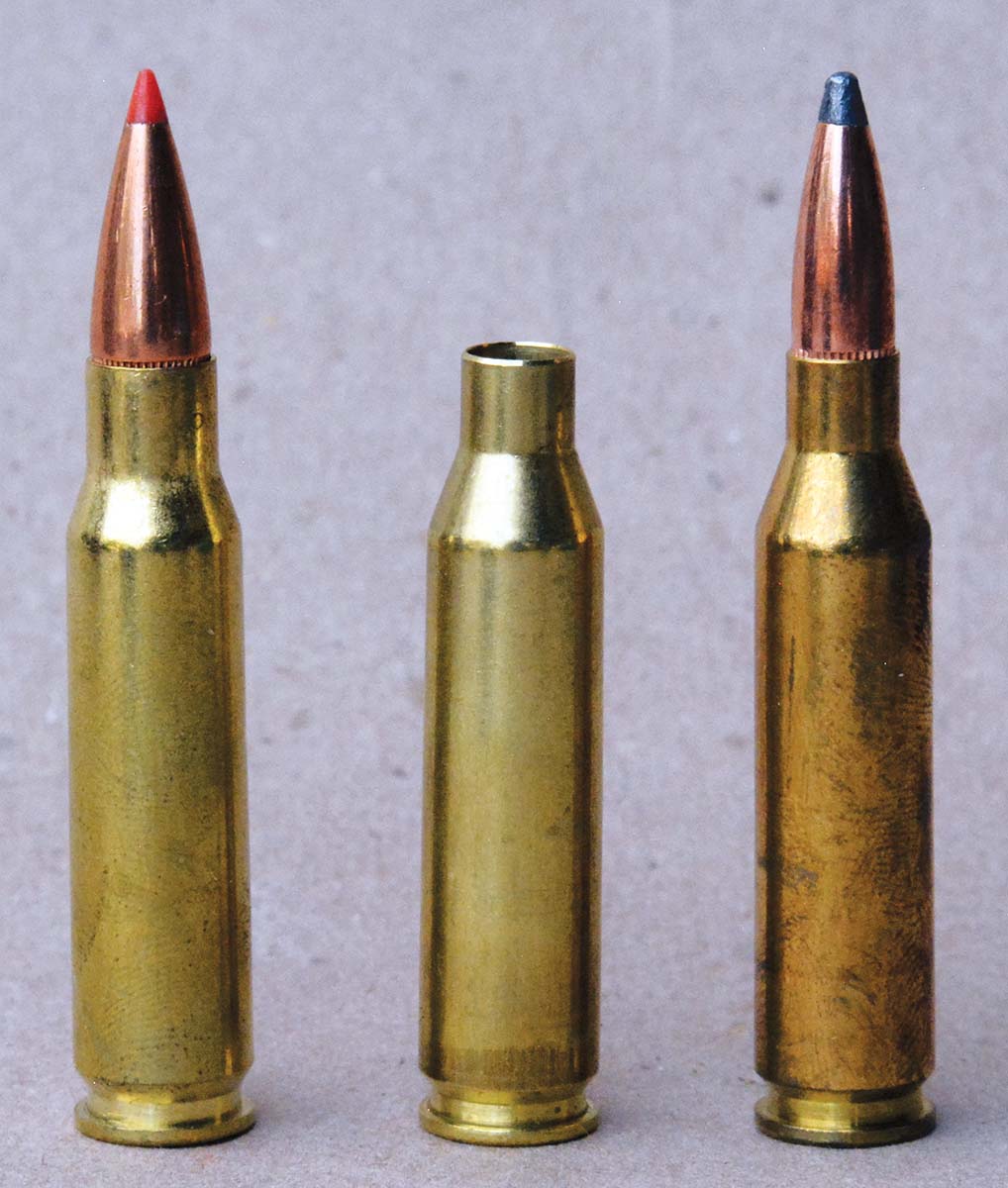
The 260 Remington (right) is based on the 308 Winchester case (left) and even shares the same shoulder angle but necked to accept 6.5/.264-inch bullets.
As indicated, most of the focus on 260 Remington “Pet Loads” has been with hunting bullets. I found many of the varmint bullets to shoot very well in the Ruger rifle. For example, the Nosler 90-grain Varmageddon, the 100-grain Ballistic Tip and the Hornady 95-grain V-MAX all gave very good accuracy, and velocities often reached 3,300 to 3,350 fps. Great deer bullets generally start with various 120-grain bullets such as the 120-grain Nosler Ballistic Tip, 125- and 140-grain Partition (also a great choice for elk and moose) and 130-grain AccuBond. The Hornady 123, 129 and 140-grain SST (Super Shock Tipped) are likewise excellent choices and are widely popular. The 143-grain ELD-X is an outstanding bullet, with select loads easily reaching 2,750 fps even from the comparatively short 22-inch barrel of the Ruger rifle. The ELD-X is capable of taking larger species such as elk and moose. The Barnes 120-grain TTSX bullet has proven very effective due to its expansion and deep penetration qualities and is a good choice for larger game, but it has also proved very accurate.
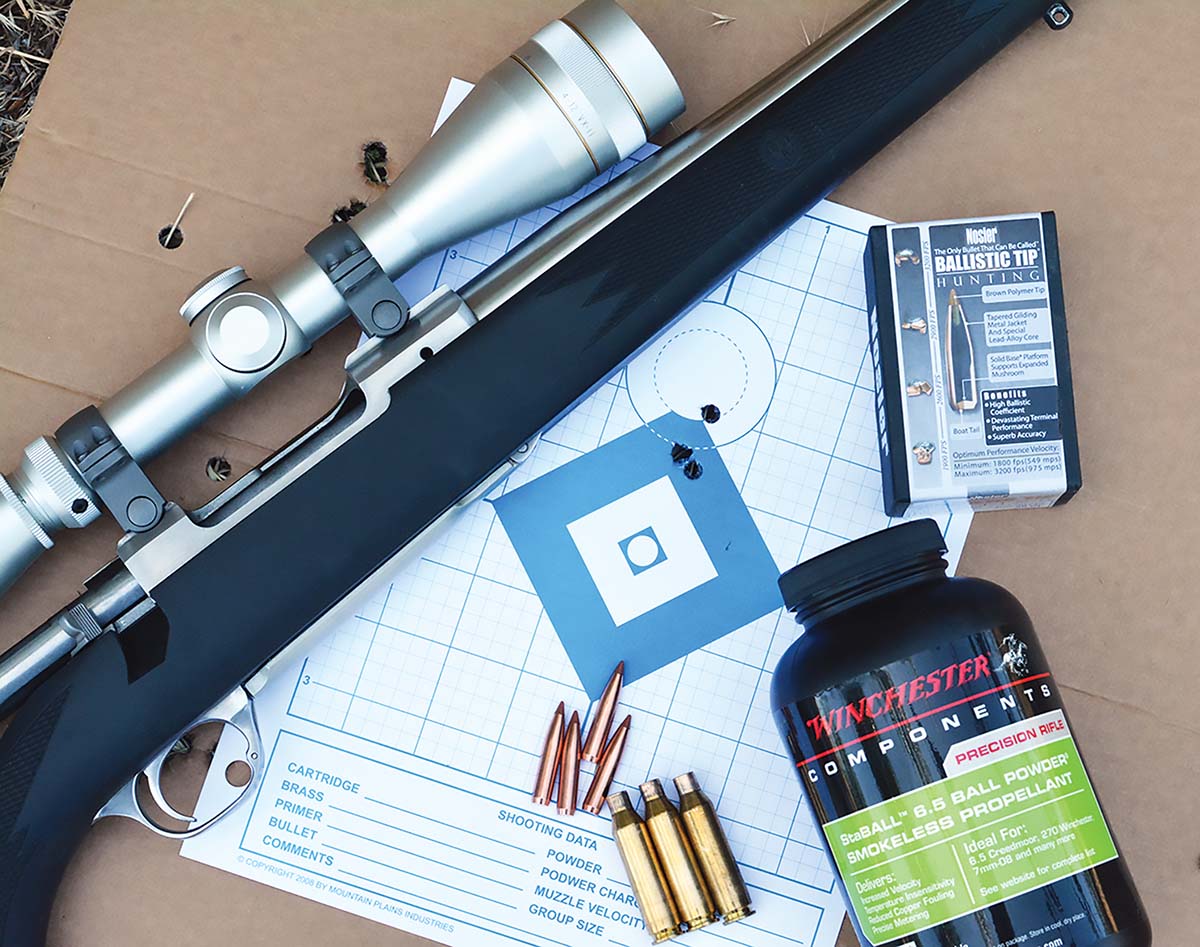
The Ruger M77 Mark II gave respectable accuracy with this group measuring just under .75 inch.
The 260 Remington thrives on powders that typically perform well in the 30-06 Springfield and similar cartridges. Consequently, there is a huge variety of excellent powders that include both extruded and spherical (aka Ball) powders. Due to differences from one rifle to the next in regards to chamber and bore dimensions, throat length and barrel twist rate, it is advisable to begin with suggested start loads and then work up to the maximum powder charges. To avoid erratic velocities and possible hang fires, suggested start loads with spherical powders should not be reduced. Many of the potentially most accurate loads often produced a single-digit extreme spread that further adds to the potential accuracy of the 260 Remington.
It is clear that the 6.5 caliber is now well-founded in the U.S. and is here to stay. In working extensively with the 260 Remington several times over the past 28 years, which has included testing rifles, factory loads and developing handload data, I have always been impressed with its overall consistent performance. As indicated, trends have been towards match cartridges with long, ultra-high BC bullets. However, the 260 Remington is still a great hunting cartridge that offers modest recoil, accuracy and is capable of taking most thin-skinned game. There are many truly outstanding hunting bullets that are well-suited for game and terrain. With both traditional and new powders, its ballistics and accuracy can be further improved through handloading.
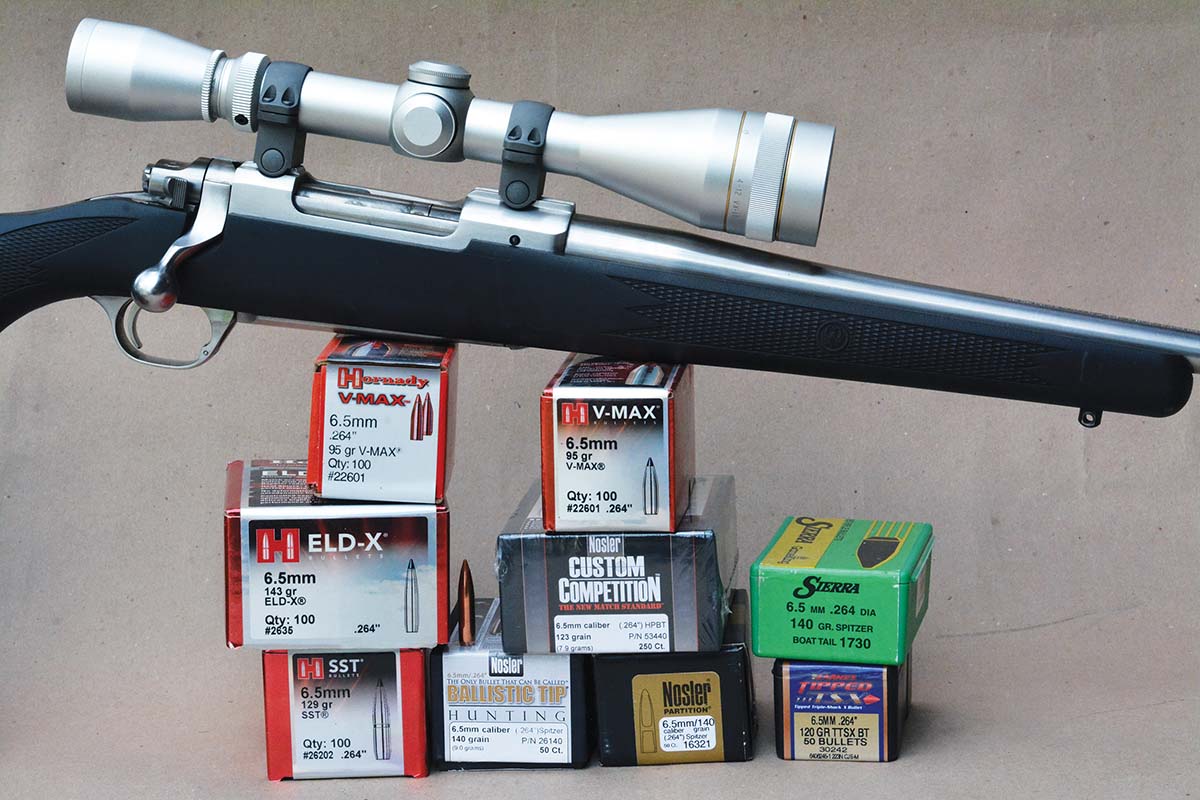
The 260 Remington will stabilize a variety of bullet weights and styles.












.jpg)
.jpg)


